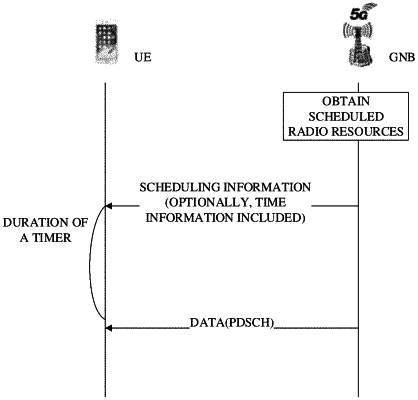| CPC H04W 72/535 (2023.01) [H04W 56/0045 (2013.01); H04W 72/1263 (2013.01); H04W 72/23 (2023.01); H04W 72/566 (2023.01); H04W 76/27 (2018.02)] | 13 Claims |

|
1. A method for resource scheduling of a network node, comprising:
obtaining time-frequency resources scheduled for user equipment (UE); and
transmitting scheduling information to the UE, wherein the scheduling information comprises the scheduled time-frequency resources and time information,
wherein the scheduling information is configured to indicate an activation time of the scheduled time-frequency resources and instruct the UE to use the scheduled time-frequency resources to transmit or receive data after a predetermined time has elapsed from the UE having received the scheduling information,
wherein the predetermined time is determined by the network node and the UE in advance through negotiation or is specified in specification or standard,
wherein the scheduled time-frequency resources are activated when the predetermined time has elapsed from the UE having received the scheduling information,
wherein the scheduling information has a predefined priority at least with respect to semi-persistent scheduling and dynamic scheduling,
wherein the time information is configured to instruct the UE to use the scheduled time-frequency resources to transmit or receive data at a time indicated by the time information, and
wherein
the time information comprises a first time offset and a second time offset, the first time offset is configured to instruct the UE to use the scheduled time-frequency resources to transmit or receive data at a time indicated by the first time offset, the second time offset is configured to indicate for the UE that the scheduled time-frequency resources are no longer available for the UE at a time indicated by the second time offset, and the time indicated by the second time offset is longer than the time indicated by the first time offset, or
the time information is configured to trigger a first timer and a second timer configured at the UE at the same time when the UE has received the scheduling information, instruct the UE to use the scheduled time-frequency resources to transmit or receive data when the first timer expires, and indicate for the UE that the scheduled time-frequency resources are no longer available for the UE when the second timer expires, the second timer expires later than the first timer, the first timer is used for indicating the activation time of the scheduled time-frequency resources, and the second timer is used for indicating the deactivation time of the scheduled time-frequency resources.
|